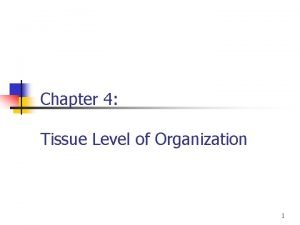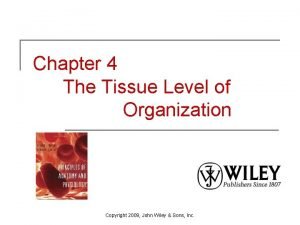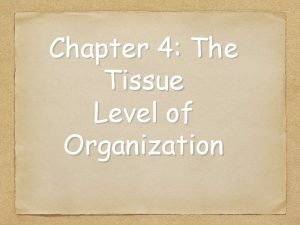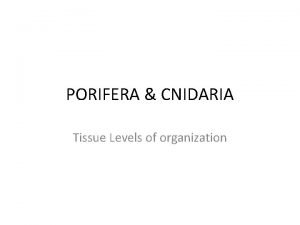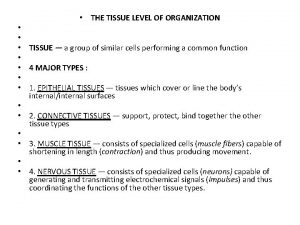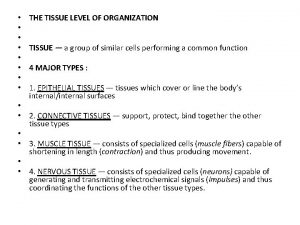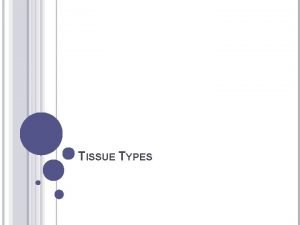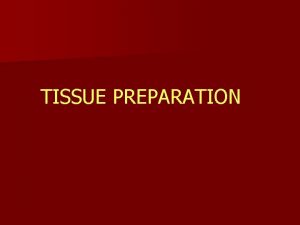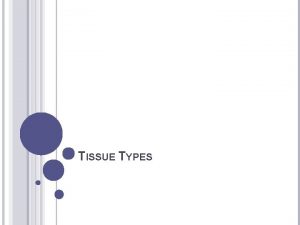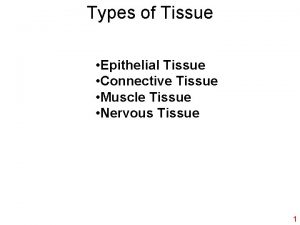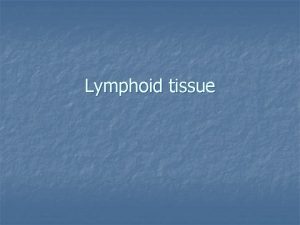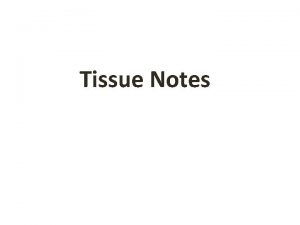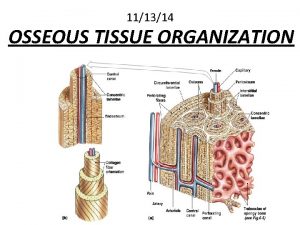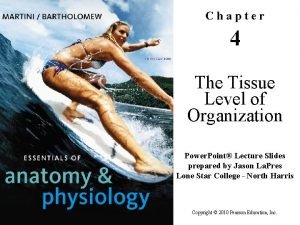Chapter 4 The Tissue Level of Organization 4






















- Slides: 22

Chapter 4: The Tissue Level of Organization

4 Tissues of the Human Body 1. ) 2. ) 3. ) 4. ) Epithelial Connective Muscle Neural

What is a tissue? Tissues are collections of cells and cell products that perform specific, but limited functions. Histology- the study of tissues and their functions.

Epithelial Tissue • Covers exposed surfaces • Lines internal passageways • Forms glands

Functions of Epithelial Tissue 1. Provide physical protection 2. Control permeability (absorption) 3. Provide sensation 4. Produce specialized secretions

Characteristics of Epithelia 1. 2. 3. 4. 5. Cellularity (cell junctions) Polarity (apical and basal surfaces) Attachment (basal lamina) Avascularity (lack blood vessels) Regeneration (short life)

Epithelia Classes Look at how they are organized close together

Simple Squamous Epithelium Areas Found 1. ) Mesothelia lining of body cavities. 2. ) Endothelia lining of heart and blood vessels. 3. ) Portions kidney tubules. 4. ) Inner lining of cornea and alveoli. Function- Reduces friction in the cavity, increases permeability, performs secretion and absorption. Thin, Flat and Irregular in Shape Alveoli Sacs in the lungs

Simple Cuboidal Epithelium Found in- Ovaries, Testes, Kidney tubules, ducts in the pancreas, Liver, Salivary Glands. Used for- Secretions, Absorption and Filtration. Hexagonal boxes

Long, thin and rectangular in shape Found in- Lining of the stomach, intestines, gallbladder, uterine tubules and collecting ducts of the kidney. Function- Protection, secretion, and absorption.

Stratified Squamous Epithelium Found in: outer layer of the skin. oral cavity, throat, vagina, anal canal Stratified Epithelium is generally located in areas that need protection from mechanical or chemical stresses like the lining of the mouth or skin Stratified Cuboidal Epithelium Found in: mammary glands sweat glands pancreas ovarian follicles Stratified Columnar Epithelium Found in: vas-deferens, male urethra parts of the pharynx

Glandular Epithelia Release secretions in the Endocrine or Exocrine Glands. Composed of glands for specific excretions. Example: Sweat, Intestines, mammary.

Most common mode of secretion Exocytosis-Merocrine secretion Apocrine secretion-partial loss of cell for secretion Holocrine secretion- cells is lost for secretion

Glandular Epithelium Types • • • Endocrine/Ductless glands- release their secretions directly into interstitial fluid like the blood, stomach, intestines etc. Secretions- normally called hormones and initiate the start of something. Examples- pancreas, pituitary, hypothalamus, thyroid, or adrenal.

Glandular Epithelium Types • • • Exocrine/ Glands with a duct- These glands secrete contents to a duct that will then empty onto the surface of the skin or on the lining of a tract. Secretions- milk from mammary glands, sweat for the skin, tears for the eyes, or enzymes for the digestive tract. Examples- Salivary, Mammary, Sweat, Tear, Gall bladder, Pancreas.

• • • Classification of Ducts Simple- Tubular or Alveolar (straight or is it round like a bulb) Simple branched or alveolar Compound- More than one attached to the same opening. Compound tubular or compound alveolar Tubuloalveolar- Gland that possesses both tubular and alveolar ducts.


Secretion Methods • • • Merocrine- most common way for secretions in the body. Secretions are completed through exocytosis of a vesicle. Apocrine- Portion of the cell is pinched off and lost through secretion (breast milk) Holocrine- Mature cell grows with secretion amounts and burst during the secreting. Cell dies and is replaced.


Epithelial Tissue Identification Lab Receive a slide from Mr. Quinn Place the slide on your microscope Use the best magnification for best view Compare view to drawings done on epithelial tissue Identify Epithelial tissue type Explain features in view that support your answer. Label those features in your drawings. Also take a picture with your phone.


 Chapter 4 the tissue level of organization
Chapter 4 the tissue level of organization Chapter 4 the tissue level of organization
Chapter 4 the tissue level of organization Chapter 4 the tissue level of organization
Chapter 4 the tissue level of organization Porifera tissue organization
Porifera tissue organization Jaringan epitel dapat ditemukan di
Jaringan epitel dapat ditemukan di Chapter 3 the cellular level of organization
Chapter 3 the cellular level of organization The chemical level of organization
The chemical level of organization The chemical level of organization chapter 2
The chemical level of organization chapter 2 Process organization in computer organization
Process organization in computer organization Block comparison vs point by point
Block comparison vs point by point Ecological pyrimid
Ecological pyrimid Hình ảnh bộ gõ cơ thể búng tay
Hình ảnh bộ gõ cơ thể búng tay Slidetodoc
Slidetodoc Bổ thể
Bổ thể Tỉ lệ cơ thể trẻ em
Tỉ lệ cơ thể trẻ em Chó sói
Chó sói Tư thế worms-breton
Tư thế worms-breton Alleluia hat len nguoi oi
Alleluia hat len nguoi oi Môn thể thao bắt đầu bằng từ chạy
Môn thể thao bắt đầu bằng từ chạy Thế nào là hệ số cao nhất
Thế nào là hệ số cao nhất Các châu lục và đại dương trên thế giới
Các châu lục và đại dương trên thế giới Cong thức tính động năng
Cong thức tính động năng Trời xanh đây là của chúng ta thể thơ
Trời xanh đây là của chúng ta thể thơ
